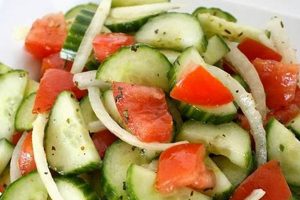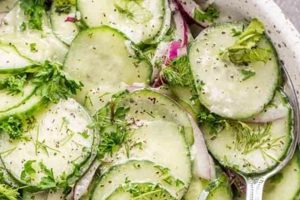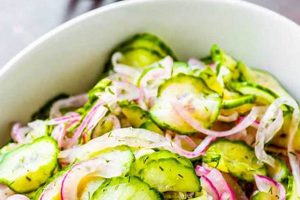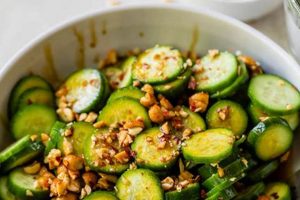A refreshing and subtly sweet side dish, this Japanese culinary creation typically features thinly sliced cucumbers marinated in a blend of rice vinegar, sugar, and soy sauce. Variations may include sesame seeds, chili flakes, or seaweed for added flavor and texture. It exemplifies the Japanese emphasis on simple, fresh ingredients and balanced flavors.
This style of salad offers a light and healthy complement to richer Japanese dishes, acting as a palate cleanser. Its simplicity makes it a quick and easy addition to any meal, while the vinegar-based marinade provides a tangy counterpoint to savory or umami flavors. Its origins likely lie in the broader Japanese culinary tradition of utilizing seasonal vegetables in pickled or marinated preparations, a practice rooted in both preservation and flavor enhancement.
The following sections will delve into specific variations, ingredient selection, detailed preparation methods, and tips for optimal presentation of this versatile dish.
Tips for an Excellent Cucumber Salad
Achieving optimal flavor and texture requires attention to detail throughout the preparation process. The following tips offer guidance for a successful outcome.
Tip 1: Cucumber Selection: Choose firm, unwaxed cucumbers for best results. Persian or Japanese cucumbers are ideal due to their thin skin and minimal seeds.
Tip 2: Slicing Technique: Thinly and evenly sliced cucumbers ensure even marination and a pleasant texture. A mandoline slicer can achieve consistent thinness.
Tip 3: Salting and Draining: Salting the cucumber slices prior to marinating draws out excess moisture, preventing a watery salad and promoting crispness. Gently pat dry after draining.
Tip 4: Marinade Balance: Achieving the right balance of sweet, sour, and salty is crucial. Adjust the proportions of rice vinegar, sugar, and soy sauce to taste.
Tip 5: Sesame Seeds: Toasting sesame seeds enhances their nutty flavor and adds a subtle crunch. Sprinkle toasted seeds over the salad just before serving.
Tip 6: Chilling Time: Allowing the salad to chill for at least 30 minutes allows the flavors to meld and the cucumbers to absorb the marinade fully.
Tip 7: Garnishing: A simple garnish elevates presentation. Consider thinly sliced red chili peppers for a touch of heat and visual appeal, or a sprinkle of dried seaweed flakes for umami.
By following these tips, one can consistently produce a refreshing and flavorful cucumber salad that complements a variety of dishes. Attention to detail in each step, from ingredient selection to final presentation, ensures a delightful culinary experience.
The following section provides a complete recipe incorporating these tips, guiding readers through each step of the preparation process.
1. Thinly Sliced Cucumbers
Thinly sliced cucumbers are a defining characteristic of Osaka-style cucumber salad. The slicing method significantly impacts the final dish’s texture, flavor absorption, and overall aesthetic appeal. Understanding the nuances of this technique is crucial for replicating authentic flavors and presentation.
- Surface Area Maximization
Thin slicing maximizes the cucumber’s surface area, allowing for greater absorption of the marinade. This ensures that each bite is infused with the desired balance of sweet, sour, and salty flavors. Increased surface area also contributes to a more delicate, palatable texture.
- Texture Enhancement
Thinly sliced cucumbers offer a delicate, almost translucent quality, contrasting with thicker cuts. This delicate texture provides a pleasant contrast to other components of a Japanese meal, offering a refreshing counterpoint to richer, more savory dishes. The thin slices also contribute to a light and crisp mouthfeel.
- Visual Appeal
The translucent nature of thinly sliced cucumbers allows for elegant presentation. The delicate slices can be arranged attractively, enhancing the visual appeal of the salad. This attention to detail reflects the broader Japanese culinary emphasis on aesthetics and artful presentation.
- Rapid Marination
Thin slices facilitate rapid marination, allowing the flavors to penetrate the cucumber quickly and evenly. This is particularly beneficial for this style of salad, which is often served chilled and relies on the balanced interplay of marinade flavors with the fresh cucumber taste.
The emphasis on thinly sliced cucumbers within Osaka-style cucumber salad highlights the interconnectedness of technique and outcome in Japanese cuisine. From enhanced flavor absorption to textural and visual appeal, this seemingly simple preparation step significantly contributes to the dish’s overall success. It showcases the attention to detail and nuanced approach that characterizes Japanese culinary traditions.
2. Rice Vinegar Marinade
Rice vinegar marinade forms the foundation of an Osaka-style cucumber salad, contributing the characteristic tangy, subtly sweet, and salty flavor profile that defines this refreshing dish. An understanding of its components and their interplay is essential for replicating authentic flavors.
- Acidity and Brightness
Rice vinegar provides the essential acidity that balances the cucumber’s inherent mildness. This tartness acts as a palate cleanser and complements richer dishes often served alongside the salad. Different types of rice vinegar, such as seasoned or unseasoned, offer varying levels of acidity and sweetness, allowing for nuanced flavor adjustments.
- Sweetness and Balance
Sugar tempers the rice vinegar’s sharpness, creating a balanced sweet-and-sour profile. The level of sweetness can be adjusted to personal preference, typically ranging from a subtle hint to a more pronounced sweetness. This balance is crucial for achieving the harmonious flavor characteristic of Osaka-style cuisine.
- Salt and Umami Enhancement
Salt, typically in the form of soy sauce or sea salt, enhances the other flavors in the marinade and adds a savory depth. Soy sauce contributes a subtle umami note, complementing the vinegar and sugar. The salt also helps to draw out excess moisture from the cucumbers, contributing to a crisper texture.
- Flavor Infusion and Preservation
The marinade not only flavors the cucumbers but also acts as a mild preservative, extending their shelf life. The vinegar’s acidity inhibits bacterial growth, allowing the salad to remain fresh for longer. This aspect reflects the practical origins of many Japanese pickled and marinated vegetable dishes.
The carefully balanced interplay of acidity, sweetness, and salt within the rice vinegar marinade is fundamental to the Osaka cucumber salad’s success. This marinade exemplifies the Japanese culinary emphasis on harmony and balance, where individual components contribute to a unified and refreshing whole. Its simplicity belies its crucial role in creating a dish that is both light and flavorful.
3. Subtle Sweetness
Subtle sweetness plays a crucial role in the Osaka cucumber salad recipe, balancing the tartness of the rice vinegar and contributing to the overall harmony of flavors. This delicate sweetness distinguishes the salad from other cucumber preparations, enhancing its refreshing qualities and complementing the other components of a Japanese meal.
- Balance of Flavors
The subtle sweetness acts as a counterpoint to the acidity of the rice vinegar, preventing the marinade from being overly tart. This balance is essential for achieving the characteristic refreshing quality of the salad. Without this sweetness, the vinegar’s sharpness could overpower the delicate cucumber flavor. The interplay between sweet and sour creates a more complex and nuanced taste profile.
- Flavor Enhancement
The addition of sugar, often in small amounts, enhances the inherent flavors of the cucumber and other ingredients in the marinade. It rounds out the overall taste profile, creating a more harmonious and palatable experience. This subtle enhancement allows the fresh cucumber flavor to shine through while adding depth.
- Cultural Significance
The preference for subtle sweetness in Japanese cuisine reflects a broader cultural appreciation for balance and harmony in flavors. This approach avoids overly strong or dominant tastes, allowing the individual ingredients to complement one another. The restrained use of sugar in Osaka-style cucumber salad aligns with this culinary philosophy.
- Versatility and Pairing
The subtle sweetness makes the salad versatile, allowing it to pair well with a wide range of Japanese dishes. It complements both savory and umami-rich foods, acting as a palate cleanser and enhancing the overall dining experience. For example, it balances the richness of grilled fish or the saltiness of soy sauce-based dishes.
The subtle sweetness in Osaka cucumber salad is more than just a flavor component; it’s a key element that contributes to the dish’s balance, versatility, and cultural significance. It exemplifies the Japanese culinary principle of using simple ingredients to create complex and harmonious flavors, resulting in a refreshing and satisfying culinary experience.
4. Optional Sesame Seeds
While not strictly mandatory, sesame seeds frequently enhance Osaka-style cucumber salad, contributing both textural and flavor complexity. Their presence, though optional, provides a nuanced layer that elevates the overall sensory experience. Understanding their role within this culinary context provides further insight into the dish’s adaptable nature.
- Flavor Enhancement
Sesame seeds offer a subtle nutty flavor that complements the cucumber and marinade. Toasting the seeds before adding them to the salad amplifies this nuttiness, creating a deeper, more complex flavor profile. The slight bitterness of toasted sesame also balances the sweetness and acidity of the marinade.
- Textural Contrast
The small, firm seeds introduce a subtle crunch, contrasting with the soft, delicate texture of the cucumber slices. This textural variation enhances the overall eating experience, adding an element of interest and preventing the salad from feeling monotonous.
- Visual Appeal
Sprinkling sesame seeds over the salad adds visual interest, creating a more appealing presentation. The small, dark seeds contrast with the light green cucumber, enhancing the dish’s aesthetics. This visual element reflects the Japanese culinary emphasis on presentation.
- Nutritional Value
Sesame seeds offer nutritional benefits, adding a small amount of protein, fiber, and healthy fats to the salad. While their contribution to overall nutrition in a single serving might be modest, their inclusion aligns with the broader emphasis on wholesome ingredients within Japanese cuisine.
The inclusion of sesame seeds, while optional, demonstrates the potential for nuanced customization within the Osaka cucumber salad framework. This seemingly minor addition exemplifies how careful consideration of even small details can significantly impact the overall sensory experience, highlighting the depth and adaptability of Japanese culinary practices. Even without sesame seeds, the salad remains refreshing and flavorful, demonstrating its versatility and adaptability to individual preferences.
5. Refreshing, Light Side Dish
The characterization of Osaka cucumber salad as a “refreshing, light side dish” speaks directly to its role within a larger Japanese meal and highlights its inherent qualities. This designation emphasizes the salad’s intended functionto provide a contrasting element that balances richer, more complex flavors and textures. Examining specific facets of this description reveals a deeper understanding of the salad’s culinary significance.
- Palate Cleanser
The refreshing nature of Osaka cucumber salad stems from its light, crisp texture and the balanced acidity of its marinade. These qualities allow it to act as a palate cleanser, cutting through the richness of other dishes and preparing the palate for subsequent flavors. For instance, following a bite of tempura or teriyaki, the salad’s bright, tangy notes reset the taste buds, preventing flavor fatigue.
- Digestive Aid
The light nature of the salad, combined with the digestive properties often attributed to vinegar, makes it a suitable accompaniment to heavier meals. The vinegar in the marinade can stimulate digestive enzymes, aiding in the breakdown of richer foods. This aspect reflects a broader focus on incorporating ingredients believed to promote digestive health in Japanese cuisine.
- Contrast and Balance
Within a Japanese meal, dishes are often selected to create a harmonious balance of flavors and textures. The light, refreshing cucumber salad provides a stark contrast to richer, heavier elements, such as fried foods or intensely savory dishes. This balance prevents the meal from feeling overly heavy or monotonous.
- Seasonal Harmony
Cucumbers are a popular summer vegetable in Japan, and their refreshing qualities make them particularly appealing during warmer months. Serving Osaka cucumber salad as a light side dish aligns with the Japanese culinary tradition of incorporating seasonal ingredients, emphasizing freshness and harmony with nature.
The description of Osaka cucumber salad as a “refreshing, light side dish” accurately captures its function and culinary significance within a Japanese meal. By acting as a palate cleanser, digestive aid, and source of contrast and balance, the salad contributes to a more complete and harmonious dining experience. Its inherent lightness and refreshing qualities align perfectly with the broader principles of Japanese cuisine, which emphasize seasonality, balance, and the interplay of simple yet complex flavors.
Frequently Asked Questions
This section addresses common inquiries regarding Osaka-style cucumber salad preparation, offering concise and informative responses.
Question 1: What type of cucumber is best suited for this salad?
While any cucumber variety can be used, Japanese or Persian cucumbers are preferred due to their thin skin, minimal seeds, and delicate flavor. These varieties require less preparation and contribute to a more refined texture.
Question 2: Can the salad be prepared in advance?
Yes, the salad can be prepared several hours in advance. In fact, chilling the salad allows the flavors to meld and enhances the refreshing qualities. However, it’s best to add any crunchy toppings, such as sesame seeds, just before serving to maintain their texture.
Question 3: What can be substituted for rice vinegar?
While rice vinegar is traditional, white wine vinegar or apple cider vinegar can be used as substitutes. However, these alternatives may subtly alter the final flavor profile. Adjusting the sugar content might be necessary to achieve the desired balance.
Question 4: How long should the cucumbers be salted before marinating?
Salting the cucumbers for 15-20 minutes is typically sufficient to draw out excess moisture. Over-salting can result in an overly salty salad, so adhere to the recommended time frame. Thoroughly pat the cucumber slices dry after salting.
Question 5: Can other seasonings be added to the marinade?
While the traditional recipe emphasizes simplicity, other seasonings can be incorporated to personalize the flavor profile. A small amount of grated ginger, finely chopped chili, or a dash of sesame oil can add complexity. However, maintain a balance to avoid overpowering the core cucumber flavor.
Question 6: How should the salad be stored?
Store leftover salad in an airtight container in the refrigerator for up to 2 days. The texture may soften slightly over time due to the marinade, but the flavor will remain intact. Consume within this timeframe for optimal quality.
Understanding these frequently asked questions and their corresponding answers ensures consistent success in preparing Osaka cucumber salad. Attention to these details contributes to a final product that authentically captures the dish’s intended refreshing and balanced flavor profile.
Further exploration of regional variations and advanced techniques can enhance one’s appreciation and mastery of this simple yet elegant culinary creation.
Osaka Cucumber Salad Recipe
This exploration of the Osaka cucumber salad recipe has highlighted its essential components: thinly sliced cucumbers, a balanced rice vinegar marinade featuring subtle sweetness, and the optional addition of sesame seeds. The preparation methods emphasize achieving optimal texture and flavor, from the salting and draining of cucumbers to the careful balancing of marinade ingredients. The salad’s role as a refreshing, light side dish within a Japanese meal underscores its importance in providing contrast and balance to richer flavors.
The simplicity of this dish belies its culinary significance. From its emphasis on fresh, seasonal ingredients to its embodiment of core Japanese culinary principles like balance and harmony, the Osaka cucumber salad offers a compelling example of how seemingly simple preparations can achieve profound culinary impact. Further exploration of regional variations and personal adaptations promises to deepen appreciation for this versatile and enduring culinary creation.






